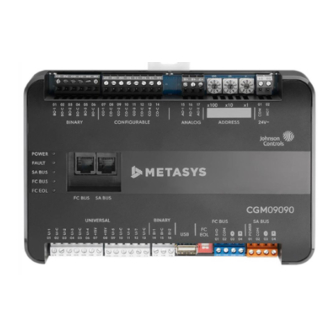Table of Contents
Advertisement
Application
The CGM09090 General Purpose Application MS/
TP Controller (CGM) are equipment controllers
that run pre-engineered and user-programmable
applications, and provides the inputs and outputs
required to monitor and control a wide variety of
HVAC and other facility equipment. CGM controllers
operate on an RS-485 BACnet® MS/TP Bus as
BACnet Advanced Application Controllers (B-AACs)
and integrate into Johnson Controls® and third-
party BACnet systems.
CGM equipment controllers include an integral real-
time clock, which enables the controllers to monitor
and control schedules, calendars, and trends, and
operate for extended periods of time as stand-alone
controllers when offline from the Metasys
network.
Communications Protocols
The CGM controllers can communicate using BACnet
MS/TP, N2, or wireless Zigbee
CGM controllers communicate using the BACnet
MS/TP protocol. The BACnet protocol is a standard
for ANSI, ASHRAE, and the International Standards
Organization (ISO) for building controls.
The CGM controllers can be used as functional
replacements for legacy N2 controllers. The N2-
capable MS/TP equipment controller models
provide a cost-effective upgrade and modernization
path for customers with existing N2 controllers.
For installation and commissioning support,
and tips for efficient and safe replacement,
refer to the Modernization Guide for Legacy N2
Controllers (LIT-12012005) and the controller-
specific documentation. For information about
mapping N2 Objects in controllers with switchable
communications protocols, refer to the N2
Compatibility Options chapter of the Controller Tool
Help (LIT-12011147).
To configure CGM controllers to communicate using
the N2 communications protocol, see
N2
communications.
The CGM controller can also be installed in a
wireless application using aZFR/ZFR Pro Wireless
Field Bus Router. To configure these controllers to
communicate using the wireless communications
protocol, see
Configuring wireless
M4-CGM General Purpose Application
system
®
. By default, the
®
Configuring
communications.
Controllers Installation Guide
North American Emissions
Compliance
United States
This equipment has been tested and found to
comply with the limits for a Class A digital device
pursuant to Part 15 of the FCC Rules. These limits
are designed to provide reasonable protection
against harmful interference when this equipment
is operated in a commercial environment. This
equipment generates, uses, and can radiate radio
frequency energy and, if not installed and used in
accordance with the instruction manual, may cause
harmful interference to radio communications.
Operation of this equipment in a residential area
may cause harmful interference, in which case the
users will be required to correct the interference at
their own expense.
Canada
This Class (A) digital apparatus meets all the
requirements of the Canadian Interference-
Causing Equipment Regulations.
Cet appareil numérique de la Classe (A) respecte
toutes les exigences du Règlement sur le matériel
brouilleur du Canada.
Installation
Observe the following guidelines when installing a
CGM Controller:
• To minimize vibration and shock damage to the
controller, transport the controller in the original
container.
• Verify that all parts shipped with the controller.
• Do not drop the controller or subject it to physical
shock.
*241014301698B*
Part No. 24-10143-01698 Rev. B
2019-10-18
(For factory use only)
M4-CGM09090
Advertisement
Table of Contents
















Need help?
Do you have a question about the M4-CGM Series and is the answer not in the manual?
Questions and answers